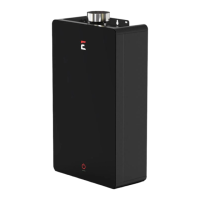PLEASE NOTE: SH12
-
A IS FOR INDOOR PERMANENT INSTALLATIONS ONLY. THIS MANUAL AND ALL ECCOTEMP CONTENT IS SUBJECTED TO CHANGE WITHOUT NOTICE.
PLEASE VISIT SUPPORT.ECCOTEMP.COM FOR MORE INFORMATION.
8
8
Support: Support.Eccotemp.com Shop Online: www.Eccotemp.com Phone: 866-356-1992
English
DANGER! NATURAL GAS AND LIQUEFIED PETROLEUM MODELS
Both liquid propane gas (LPG) and natural gas (NG) have an odorant added to aid in detecting a gas leak.
Some people may not physically be able to smell or recognize this odorant. If you are unsure or unfamiliar
with the smell of LPG or NG, ask the gas supplier. Other conditions, such as “odorant fade”, which causes the
odorant to diminish in intensity, can also hide or camouage a gas leak. Always check with commercial leak
detector or soapy water.
• Gas detectors are recommended in LPG and NG applications and their installation should be in
accordance with the detector manufacturer’s recommendations and/or local laws, rules, regulations or
customs.
• Water heaters utilizing LPG are dierent from NG models. A NG water heater will not function safely on
LPG and vice versa.
• No attempt should ever be made to convert the water heater from NG to LPG. To avoid possible
equipment damage, personal injury or re, do not connect the water heater to a fuel type not in
accordance with the water heater data plate; liquid propane gas for LPG water heaters and natural gas
for NG water heaters. These water heaters are not certied for any other fuel type.
• LPG water heaters should not be installed below grade (for example, in a basement) if such installation is
prohibited by federal, state, or local laws, rules, regulations, or codes.
• LPG must be used with great caution. It is heavier than air and will collect rst in the lower areas making
it hard to detect at nose level.
• Before attempting to light the water heater, make sure to look and smell for gas leaks. Use a soapy
solution to check all gas tting and connections. Bubbling at a connection indicates a leak that must be
corrected. When smelling to detect a gas leak, be sure to sni near the oor also.
• It is recommended that more than one method, such as soapy solution, gas detectors, etc., be used to
detect leaks in gas applications.
NOTICE! If a gas leak is present or suspected:
• DO NOT attempt to nd the cause yourself.
• DO NOT try to light any appliances.
• DO NOT touch any electrical switch.
• DO NOT use any phone in your building.
• Leave the house immediately and make sure your family and pets leave also.
• Leave doors open for ventilation and contact the gas supplier, a qualied service agency or the
re department.
• Stay away from the house (or building) until the service call has been made, the leak is corrected,
and a qualied agency has determined the area to be safe.
IMPORTANT SAFETY INFORMATION:
READ ALL INSTRUCTIONS BEFORE USING
Safety Information

